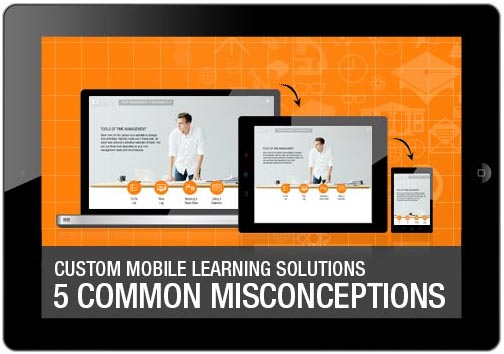
The popularity of mobile learning or mLearning continues to grow. Interestingly, integration of mobile devices into corporate learning strategies has been triggered largely by learners who want the flexibility of device they want to learn on. As a result, many corporates worldwide now have Bring Your Own Device (BYOD) policies in place and have embraced custom mobile learning or mLearning solutions in the last 2-3 years. Yet there are several misconceptions around the effectiveness of custom mobile learning or mLearning solutions. In this article I will outline five of the common misconceptions on custom mobile learning solutions. More specifically, I will share some pointers on how you can address some of these challenges and create an effective custom mobile learning solution that will work for you.
5 Common Misconceptions About Custom Mobile Learning Solutions
As I had mentioned earlier, with the increased usage of mobile devices as the preferred device for learning (particularly tablets and in recent times smartphones), mobile learning, and as an extension, custom mobile learning solutions are on an upswing.
Integration of Tablets and Smartphones provides increased flexibility to learners as they can access the same course across multiple devices. Technology allows them a seamless learning across devices.
In spite of this momentum, custom mobile learning solutions do face certain challenges and this often leads to elusive success factors. I will outline the 5 common misconceptions that I have seen so far and will provide pointers on a work-around for you to overcome them.
1. Mobile learning is eLearning lite.
This is probably the biggest misconception and often the reason why custom mobile learning solutions fail to hit the mark. Mobile learning is not eLearning lite and when you opt for custom mobile learning solutions, you need to extensively revamp your learning strategy.
2. One size fits all.
I see this as the second biggest misconception and it is related to the first misconception. When you opt for a custom mobile learning solution, you need to identify which devices would be used to access mLearning solutions. Essentially, there are two options:
- Adaptive.
These are multi-device custom mobile learning solutions that support PCs, laptops, and tablets. - Responsive.
These are multi-device custom mobile learning solutions that support PCs, laptops, tablets, and smartphones.
The inclusion of smartphones needs a reassessment of how your custom mobile learning solution needs to be designed. There are certain trade-offs in the overall learning experience when you design for the limited viewing area of a smartphone and this needs to be factored during the learning design phase. If the percentage of users opting for smartphones is very low, I would recommend the adaptive approach rather than a responsive approach. This will ensure that there is no trade-off and the same learning experience that is offered to PC/laptop users will also be available on tablets.
3. Need to factor for technology (HTML5 support), otherwise the same content and same learning strategy would work on all devices (including mobile devices).
This is another misconception that often causes a gap in the desired and the actual learning experience. While custom mobile learning solutions factor for the technology (HTML5 output), this alone is not adequate to craft the learning strategy. Mobile devices require bite-sized learning that certainly needs repurposing of the content. Similarly, you need to have user interactions that are intrinsic to mobile devices but they are equally intuitive for usage on PC/laptop. Only then can the learning experience on mobile devices be meaningful for the learners.
4. Tablets and smartphones both support HTML5, so the same learning strategy should work.
Yes, from a technology perspective, both tablets and smartphones support HTML5. The need for distinct learning strategies that should be part of your custom mobile learning solutions arises from two factors. The first one is the fact that there is a limited viewable area in a smartphone. There is another associated challenge of providing flexibility in portrait and landscape viewing on smartphones that is not very relevant for tablet users. So, the custom mobile learning solution should be crafted bottom up; that is, begin with smartphone and then move up to tablets and finally to laptops/PCs. This approach will ensure that the learners will get the same learning experience as they move across devices on the same course.
5. A complete learning experience cannot be delivered on smartphones.
This is a misconception that is very common. A complete learning experience can be delivered on smartphones provided your custom mobile learning solution factors for their limitations and builds on how learners are likely to use them in their overall learning journey.
Summary
Like all new approaches, an effective and successful implementation of mobile learning or mLearning needs a different learning strategy. I hope with the clarity on the common 5 misconceptions and, more specifically, my pointers on how you could handle the intrinsic challenges, you will be able to create custom mobile learning solutions that work.
Over the last 6+ years, we have crafted custom mobile learning solutions of over 800 hours for both formal and informal learning (Performance Support Tools). We have crafted learning strategies that work for both individual learners as well as for collaborative (social) learning. If you have any questions on how you can successfully integrate mobile learning into your current learning strategy, do reach out to me.
Read More:
- 10 Killer Examples Of Mobile Learning To Boost Employee Engagement And Performance
- How To Use Mobile Learning To Increase Employee Engagement And Boost Performance
- 10 Reasons Why You Should Use Mobile Apps For Learning In Your Learning Strategy
- Why Adopt Mobile Learning For Online Training – 10 Questions Answered



